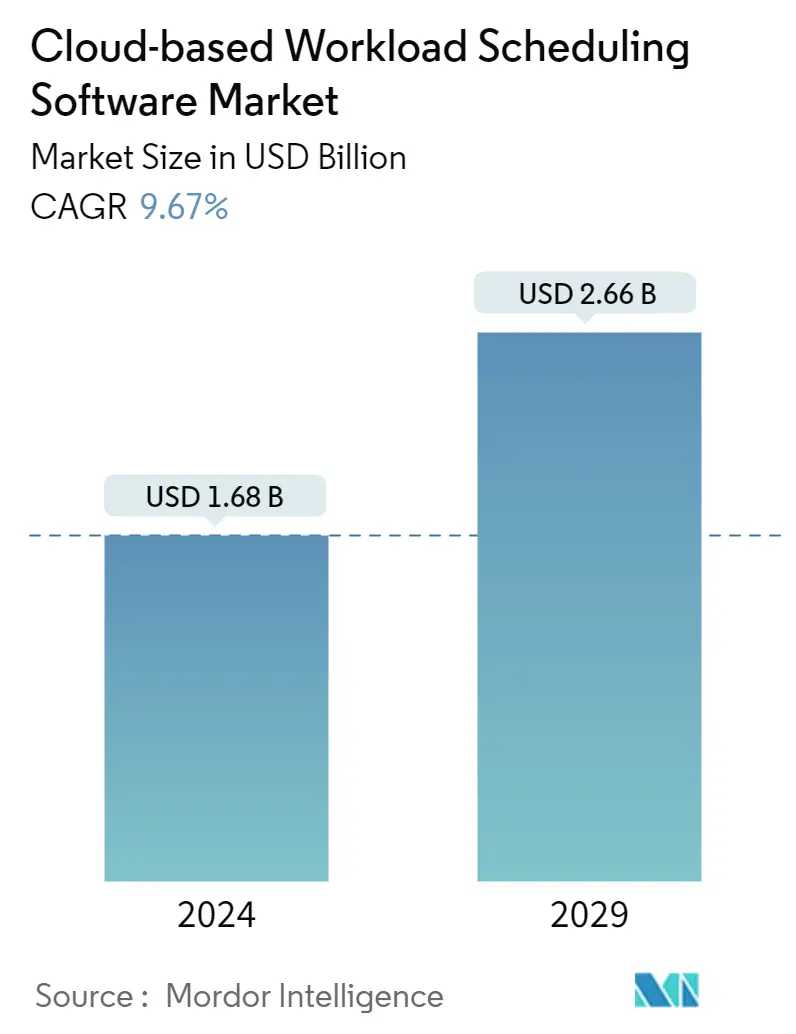Market Size of Cloud-based Workload Scheduling Software Industry

| Study Period | 2019-2029 |
| Market Size (2024) | USD 1.68 Billion |
| Market Size (2029) | USD 2.66 Billion |
| CAGR (2024 - 2029) | 9.67 % |
| Fastest Growing Market | Asia Pacific |
| Largest Market | North America |
Major Players
*Disclaimer: Major Players sorted in no particular order |
Cloud Based Workload Scheduling Software Market Analysis
The Cloud-based Workload Scheduling Software Market size is estimated at USD 1.68 billion in 2024, and is expected to reach USD 2.66 billion by 2029, growing at a CAGR of 9.67% during the forecast period (2024-2029).
As enterprises roll out new technologies, they need to consider and plan for impacts related to workload processing and the availability of critical applications across distributed and cloud environments; hence the need for better workload scheduling software is projected to increase in the future.
- The cloud-based workload scheduling software available can integrate, monitor, and operate workloads, perform analysis, and give predictions for the future. This empowers organizations with abilities to tackle problems that can arise in the future and also manage assets.
- Cloud-based workload scheduling software helps to improve workload scheduling without the need for human intervention. Sophisticated scheduling and analytical abilities help organizations increase employee efficiency. This is a significant drive for the cloud-based workload scheduling software.
- Similarly, the rapid adoption and increasing preference for cloud-based services by various multinational businesses would provide enough new opportunities, driving the expansion of the cloud-based workload scheduling software market during the forecasted period.
- However, the ease of availability, and the rapid growth of open-source software, are acting as major constraints for the growth of cloud-based workload scheduling software. The growing need to meet strict compliance and regulations has the potential to challenge the growth of cloud-based workload scheduling software.
- During the pandemic, many countries across the globe mandated work from home based on public health safety concerns that drove the need for remote working infrastructure. Therefore, organizations operating at all levels, including government bodies, expected a wide range of potential impacts, such as increased demand for virtual services coupled with rising citizen expectations around the delivery of these services, the longer-term potential for reshaping the government workforce, and the need to provide adaptive and dynamic regulatory models. Thus, such impacts necessitated the cloud-based workload scheduling software for enhanced service experience. Post-pandemic, the market grew rapidly, with enterprises shifting towards cloud-based services.
Cloud Based Workload Scheduling Software Industry Segmentation
Workload scheduling uses software to schedule, initiate, and manage everyday tasks related to business transactions. A workload, here, can be thought of as the total amount of processing that a computer or enterprise conducts at any given time. Workload scheduling software makes it possible for much of that processing to take place without human intervention. Hence, Cloud-based workload scheduling software can be used for monitoring, automating, and scheduling the enterprise's workflow employed through the cloud.
The Cloud-based workload scheduling software market is segmented by cloud (public, private, hybrid), by end-user (corporate, government), and by geography (North America, Europe, Asia Pacific, Latin America, and Middle East and Africa). The market sizes and forecasts are provided in terms of value in USD for all the above segments.
| By Cloud | |
| Public | |
| Private | |
| Hybrid |
| By End User | |
| Corporate | |
| Government | |
| Other End Users |
| By Geography | |
| North America | |
| Europe | |
| Asia Pacific | |
| Latin America | |
| Middle East & Africa |
Cloud-based Workload Scheduling Software Market Size Summary
The cloud-based workload scheduling software market is poised for significant growth as enterprises increasingly adopt cloud technologies to manage workload processing and ensure the availability of critical applications across distributed environments. This software enables organizations to integrate, monitor, and operate workloads efficiently, enhancing employee productivity through sophisticated scheduling and analytical capabilities. The shift towards cloud-based services is driven by the need for cost-effective solutions and the growing trend of automation within organizations. The pandemic accelerated this transition, highlighting the necessity for remote working infrastructure and adaptive regulatory models, which further propelled the demand for cloud-based workload scheduling software. Despite the challenges posed by the availability of open-source alternatives and the need to comply with stringent regulations, the market is expected to expand as multinational businesses continue to prefer cloud-based solutions.
North America is a key region driving the market's growth, with an increasing demand for cloud-based workload scheduling software fueled by the rise of automated and cloud-based organizations. The region's early adoption of the bring-your-own-device (BYOD) culture has led to a widespread shift towards hybrid cloud models, balancing the need for data security with the accessibility of applications. Major players and new entrants are actively enhancing their offerings through strategic partnerships and acquisitions, aiming to capture a larger market share. The ongoing development of tools to support hybrid and multi-cloud environments, along with the emphasis on data integrity and privacy, is expected to further boost the adoption of cloud-based workload scheduling software. As organizations seek to optimize operations and reduce costs, the market is set to witness continued expansion, providing ample opportunities for leading vendors to grow.
Cloud-based Workload Scheduling Software Market Size - Table of Contents
-
1. MARKET INSIGHTS
-
1.1 Market Overview
-
1.2 Industry Value Chain Analysis
-
1.3 Industry Attractiveness - Porter's Five Forces Analysis
-
1.3.1 Threat of New Entrants
-
1.3.2 Bargaining Power of Buyers/Consumers
-
1.3.3 Bargaining Power of Suppliers
-
1.3.4 Threat of Substitute Products
-
1.3.5 Intensity of Competitive Rivalry
-
-
1.4 Impact of COVID-19 on the Market
-
-
2. MARKET SEGMENTATION
-
2.1 By Cloud
-
2.1.1 Public
-
2.1.2 Private
-
2.1.3 Hybrid
-
-
2.2 By End User
-
2.2.1 Corporate
-
2.2.2 Government
-
2.2.3 Other End Users
-
-
2.3 By Geography
-
2.3.1 North America
-
2.3.2 Europe
-
2.3.3 Asia Pacific
-
2.3.4 Latin America
-
2.3.5 Middle East & Africa
-
-
Cloud-based Workload Scheduling Software Market Size FAQs
How big is the Cloud-based Workload Scheduling Software Market?
The Cloud-based Workload Scheduling Software Market size is expected to reach USD 1.68 billion in 2024 and grow at a CAGR of 9.67% to reach USD 2.66 billion by 2029.
What is the current Cloud-based Workload Scheduling Software Market size?
In 2024, the Cloud-based Workload Scheduling Software Market size is expected to reach USD 1.68 billion.

